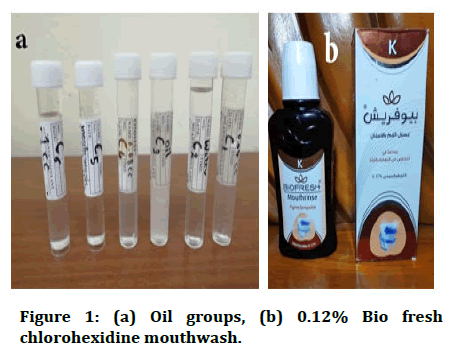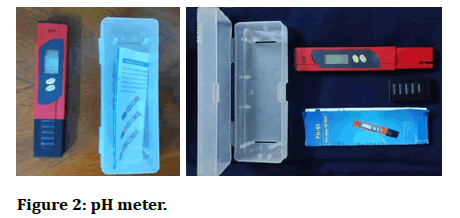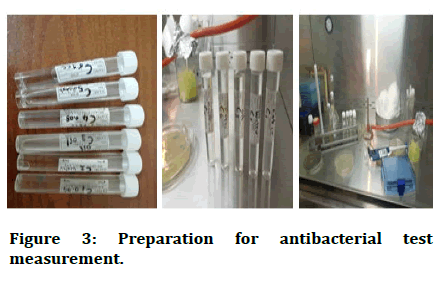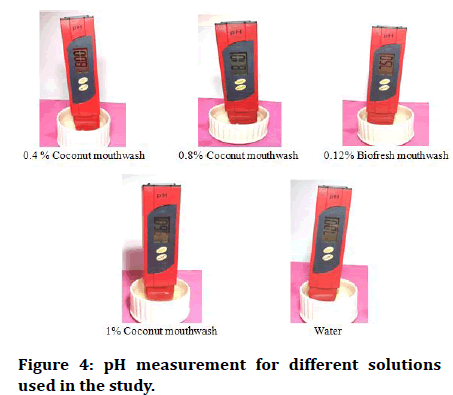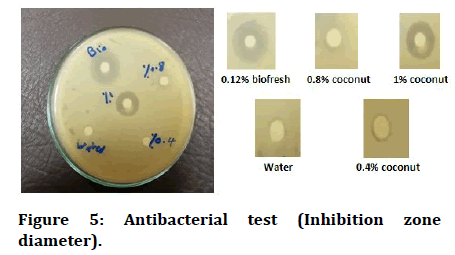Research - (2022) Volume 10, Issue 1
Evaluation of a New Mouthwash an In Vitro Study
Amer A Taqa1, Leqaa H Qibi2* and Arjwan M Shuker1
*Correspondence: Leqaa H Qibi, Department of Pedodontics, Orthopaedics and Preventive dentistry, College of Dentistry, University of Mosul, Iraq, Email:
Abstract
Objectives: To analysis the benefit effect of coconut as natural mouthwash. Methods: This study depended on using of coconut as a main constituent in making a natural mouthwash solution. It examined some physical, chemical, biological and antibacterial properties of this mouthwash by surface tension test, pH measurement and antibacterial property of mouthwash as reduction of Streptococcus mutans count. Results: The results for 1% coconut mouthwash showed: surface tension (42.35 dyne/cm) and pH measurements (9.6), which was the highest results, while the antibacterial inhibition zone diameter for 1% coconut mouthwash was (13 mm) which the 2nd highest result. Conclusions: Coconut mouthwash plays an antibacterial effect with prevention demineralization of tooth enamel surface.
Keywords
Coconut, Mouthwash, Surface tension, pH measurements antibacterial test
Introduction
The preservation of oral health can be accomplished by mouthwashes which are commonly used [1].
Mouthwashes are non-sterile aqueous solutions and used as an antibacterial activity which prevents the growth of bacteria in the mouth and teeth [2], and for decreasing oral malodor [3]. They are commonly used as topical solutions against plaque development [4], and they can be used frequently to prevent oral infections [5].
Natural mouthwashes having fewer undesirable effects, as an alternative to chemical ones [6]. Coconut oil used in making mouthwash in our study, it is considered as a unique physically functional food besides health and nutritional benefits [7].
Coconut oil is one of the healthiest oils on earth [8] which has been ingested in tropical nations for thousands of years [9].
In the commercial market, there are two types of coconut oil available: refined and virgin coconut oil. Virgin coconut oil used in mouthwash in this study is characterized by colourless, odorless liquid and has many health benefits which contain vitamins and antioxidants, it also has antiviral activity [10,11], besides it contained antimicrobial properties against wide range of species, as Mycobacterium species, Gram-positive and Gram-negative bacteria [12], coconut mouthwash considered safe and effective alternative to Chlorohixidine as antibacterial [13].
Materials and Methods
Virgin Coconut is used in preparing mouthwash in this study by using different concentrations of coconut oil (0.4%, 0.8%, and 1%) was dissolved in 500 mL of water and using sodium carbonate (molar ratio equivalent) to make solubility of coconut oil in water by making coconut salt, no sweetener, or flavouring agents. Then the solution was tested after 1 month for surface tension, pH measurement and antibacterial test measurement.
Surface tension test measurement
Surface tension measurement was done using glass capillaries which were open on both the ends. A glass capillary was immersed in a 50-mL glass beaker containing 15 mL of the product [14]. A sample of 500 ml of the following different concentration of coconut mouthwash solution: (0. 4%, 0.8% and 1%) of coconut mouthwash, and 0.12% Bio fresh chlorohixidine mouthwash (positive group), besides water (negative group).
Groups as arranged in C1, C2, C3, C4, C5 and C6 were (C1: 0.4% coconut mouthwash, C2: water, C3: coconut oil, C4: 0.8% coconut mouthwash, C5: 0.12% Bio fresh chlorohixidine mouthwash and C6: 1% coconut mouthwash) as shown in Figure 1 was filled in a beaker and a glass tube was immersed in the solution after measuring its inner diameter. Then the level of the fluid in the tube was measured by the horizontal microscope ruler the surface tension was obtained according to the following equation:
Figure 1:(a) (a) Oil groups, (b) 0.12% Bio fresh chlorohexidine mouthwash.
Ts=1/4 d h p g=dyne/cm. at temperature 33 °C [15].
d=tube diameter in cm.
h=the height the liquid is lifted in cm.
p=the density of the liquid.
g=the acceleration due to gravity.
Ts=surface tension.
This is a sample of 500 ml of the following different concentration of coconut mouthwash solution: (0. 4%, 0. 8% and 1%) of coconut mouthwash, and 0.12% Bio fresh chlorohixidine mouthwash (positive group), besides water (negative group).
The probe of the pH meter Figure 2 was immersed in the solution until the reading which appears on the screen becomes stable.
Figure 2:(a) pH meter.
Antibacterial test measurement
Gram positive Streptococcus mutans was used in this study to evaluate the antibacterial effect of different concentrations of coconut mouthwash which were studied as: (0.8%, 0. 4% and 1%,) coconut mouthwash, and antibacterial effects of 0.12% Bio fresh chlorohixidine mouthwash and water as shown in Figure 3, and by using Mueller-Hinton agar (MHA) plates. The plates were then incubated at 37 °C for 24 hours. The antibacterial activity was assessed by calculating the diameter of inhibitory zones in millimetres [16].
Figure 3:(a)Preparation for antibacterial test measurement.
Results
The Results of surface tension test, pH measurement and Antibacterial test (Inhibition zone diameter) are shown in (Table 1), and (Figures 4 and 5).
Figure 4:(a)pH measurement for different solutions used in the study.
Figure 5:(a)Antibacterial test (Inhibition zone diameter).
| Surface tension (dyne/cm) | PH measurement | Inhibition zone diameter (mm) | |
|---|---|---|---|
| 0.4% coconut mouthwash | 35.643 | 8 | 3 mm |
| 0.8% coconut mouthwash | 40.057 | 8.1 | 6 mm |
| 1% coconut mouthwash | 42.35 | 9.6 | 13 mm |
| 0.12% Bio fresh mouthwash | 20.58 | 7.5 | 16 mm |
| Water | 28.824 | 7 | 0 mm |
| Coconut oil | 12.862 | …… | …… |
Table 1: The results of surface tension test, pH measurement and antibacterial test (inhibition zone diameter).
Discussion
Surface tension
It is the contractive properties of the surface for a liquid that permit resisting an external force which is considered an important point of appropriate solution that has a low surface tension [17].
Lowering the surface tension can result in more dispersion of the mouthwash in the medium [18]. So in this study the surface tension of 0.12% Bio fresh mouthwash was (20.58 dyne/cm) which is the lowest surface tension. Then 1% coconut mouthwash which was (32.643 dyne/cm).
pH measurement
pH measurement results showed 1% coconut mouthwash has highest pH which is 9.6 very good then 0.8% coconut mouthwash has pH 8.1 then 0.4 % coconut mouthwash has pH 8 then 0.12% Bio fresh mouthwash pH 7.5.
The pH of 5.5 is regarded critical for teeth, as the teeth begin to demineralize below 5.5. where at a pH above 5.5, the teeth begin to remineralize [19,20], the acidic and low pH (less or equal to 5.5) mouthwashes can cause dental demineralization and significant loss of enamel within the first few minutes of contact with such acidic solution [21].
Antibacterial test
The antibacterial test of mouthwash achieved a noticeable positive result, %0.12 Bio fresh mouthwash produced largest zone of inhibition against Streptococcus mutans about (16 mm) then 1% coconut larger inhibition zone about (13 mm) then 0.8% about (6 mm) then 0.4% for (3 mm) [22-24].
So, oil coconut pulling can be explored as a safe and effective alternative to chlorohixidine [13].
In another point, in comparison of coconut oil and chlorohixidine there is no significant difference in the antibacterial efficacy. So, coconut oil is as effective as chlorohixidine in the reduction of Streptococcus mutans [25].
Conclusion
At the end of this study, it is found that concentration of coconut oil mouthwash increases from 0.4% to 0.8% to 1% and more benefits as alternative to other antibacterial mouthwash can be obtained. In addition, pH is more appropriate to teeth and oral cavity as it prevents demineralizing of enamel tooth surface. Besides, it is considered safe because of its natural herbal contents.
Source of Funding
This study received no financial support.
Conflict of Interest
The authors have no conflict of interest to declare.
Ethical Approval
The college of dentistry in Mosul University approved the protocol of this study.
Authors Contributions
All Authors contributed to the development of the course and the design, writing, and finalizing of the research. All authors have critically reviewed and approved the final draft and are responsible for the content and similarity index of the manuscript.
Acknowledgement
The authors appreciate and acknowledge the everyone who gave help in this research.
References
- El Basuony SA, El Hossary N, Amin NR. Apoptosis inducing effects of chlorhexidine and essential oil mouthwashes on BHK-21 fibroblast cell line: An in vitro study. F1000Res 2018; 7:1703.
- Sepideh B, Zahra A, Marzieh A, et al. Determining the antibacterial activity of chlorhexidine mouthwashes with and without alcohol against common oral pathogens. J Adv Oral Res 2018; 9:1-5.
- Barnett ML. The role of therapeutic antimicrobial mouthrinses in clinical practice: Control of supragingival plaque and gingivitis. J Am Dent Assoc 2003; 134:699-704.
- Saadatzadeh A, Ameri A, Moghimipour E, et al. Comparison of antibacterial efficacy of probiotic mouthwash with chlorhexidine against common oral pathogens: An in-vitro study. J Nat Pharm Prod 2018; 13:e65029.
- Andrea A, Eva P, Simona P, et al. In vitro effects of commercial mouthwashes on several virulence traits of Candida albicans, viridans Streptococci and Enterococcus faecalis colonizing the oral cavity. PLoS One 2018; 13:e0207262.
- Romoozi E, Bekhradi R, Talebi MR, et al. Effect of green tea mouthwash on reducing plaque and gingivitis. J Dent Health Oral Disord Ther 2018; 9:207-210.
- Amer A.Taqa, Motaz GS, Talal HM. The effect of a new endodontic irrigant solution on push out shear bond strength of a root canal filling system. Int J Enhan Res Sci Technol Eng 2014; 3:158-163.
- Mandal MD, Mandal S. Coconut (Cocos nucifera L: Arecaceae): In health promotion and disease prevention. Asian Pac J Trop Med 2011; 241-247.
- Devi LS. Molecular docking and validation of medicinal effect of coconut (Cocos nucifera L.). M.Sc. Thesis. Kerala Agricultural University, College of Horticulture, Kerala, India. 2016; 656-680.
- Bartolotta S, Garcia CC, Candurra NA, et al. Effect of fatty acids on arenaviruses replication: Inhibition of virus production by lauric acid. Arch Virol 2001; 146:777-790.
- Ogbolu DO, Oni AA, Daini OA, et al. In vitro antimicrobial properties of coconut oil on candida species in Ibadan, Nigeria. J Med Food 2007; 10:384-387.
- Motaz GS, Amer AT, Talal HM. Preparation and evaluation of a novel herbal endodontic irrigant (coconut and bromelain) conservative dentistry, PhD thesis, University of Mosul, Iraq 2015.
- Kaushik M, Reddy P, Sharma R, et al. The effect of coconut oil pulling on Streptococcus mutans count in saliva in comparison with chlorhexidine mouthwash. J Contemp Dent Pract 2016; 17:38-41.
- Al-Achi A, Kathuria A, Zahid KM. Physical characteristics of sixteen non-prescription medications: specific gravity, pH, surface tension, and rheological characteristics. J Drug Discov Develop Deliv 2015; 2:id1013.
- Nawfal AA, Amer A Taqa, Talal HA. An evaluation of a newly prepared endodontic irrigant solution. Lambert Academic Puplishing 2016.
- Haron UA, Abllah Z, Nasir NA. The comparative antimicrobial effect of activated virgin coconut oil (AVCO) and virgin coconut oil (VCO) against dental caries-related Pathogens. Adv Health Sci Res 2017; 8:312-317.
- Haapasalo M, Shen Y, Qian W, et al. Irrigation in endodontics. Dent Clin North Am 2010; 54:291-312.
- Giardino L, Ambu E, Becce C, et al. Surface tension comparison of four common root canal irrigants and two new irrigants containing antibiotic. J Endod 2006; 32:1091–1093.
- Schuelke L. The key to cavity prevention: pH in the mouth. Northeast Wisconsin 2015; 14:12.
- Saisandhya T, Vishnupriya V. Effects of aerated soft drinks on the pH levels in the oral cavity. Int J Curr Adv Res 2017; 6:3293 3294.
- Vivek S, Shwetha R. Endogenous pH, titratable acidity of commercially available mouthwashes in indian market. Int J Clin Trials 2015; 2:20-24.
- Thaweboon S, Nakaparksin J, Thaweboon B. Effect of oil-pulling on oral microorganisms in biofilm models. Asia-Pac J Public Health 2011; 2:62-66.
- Bidra AS, Tarrand JJ, Roberts DB, et al. Antimicrobial efficacy of oral topical agents on microorganisms associated with radiated head and neck cancer patients: An in vitro study. Quintessence Int 2011; 42:307-315.
- Shruti B, Radhika A. Chlorhexidine: The gold standard antiplaque agent. J Pharm Sci Res 2013; 5:270-274.
- Peedikayil FC, Remy V, John S, et al. Comparison of antibacterial efficacy of coconut oil and chlorhexidine on Streptococcus mutans: An in vivo study. J Int Soc Prevent Communit Dent 2016; 6:447-452. Indexed at, Google Scholar, Cross Ref
Indexed at, Google Scholar, Cross Ref
Indexed at, Google Scholar, Cross Ref
Indexed at, Google Scholar, Cross Ref
Indexed at, Google Scholar, Cross Ref
Indexed at, Google Scholar, Cross Ref
Indexed at, Google Scholar, Cross Ref
Indexed at, Google Scholar, Cross Ref
Indexed at, Google Scholar, Cross Ref
Indexed at, Google Scholar, Cross Ref
Indexed at, Google Scholar, Cross Ref
Indexed at, Google Scholar, Cross Ref
Indexed at, Google Scholar, Cross Ref
Indexed at, Google Scholar, Cross Ref
Author Info
Amer A Taqa1, Leqaa H Qibi2* and Arjwan M Shuker1
1Department of Dental Basic Sciences, College of Dentistry, University of Mosul, Iraq2Department of Pedodontics, Orthopaedics and Preventive dentistry, College of Dentistry, University of Mosul, Iraq
Citation: Amer A Taqa, Leqaa H Qibi, Arjwan M Shuker, Evaluation of a New Mouthwash an In Vitro Study, J Res Med Dent Sci, 2022, 10(1): 246-249
Received: 13-Dec-2021, Manuscript No. JRMDS-21-44645; , Pre QC No. JRMDS-21-44645 (PQ); Editor assigned: 15-Dec-2021, Pre QC No. JRMDS-21-44645 (PQ); Reviewed: 29-Dec-2021, QC No. JRMDS-21-44645; Revised: 03-Jan-2022, Manuscript No. JRMDS-21-44645 (R); Published: 10-Jan-2022

